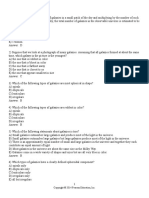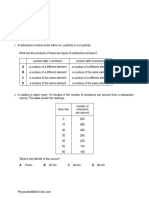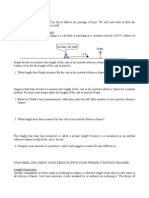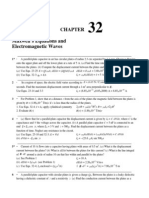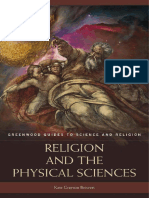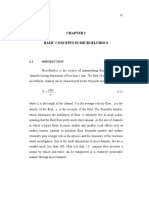Problem Sheet of Relativity-Summer 2011-12
Problem Sheet of Relativity-Summer 2011-12
Uploaded by
Shahriar RahmanCopyright:
Available Formats
Problem Sheet of Relativity-Summer 2011-12
Problem Sheet of Relativity-Summer 2011-12
Uploaded by
Shahriar RahmanOriginal Title
Copyright
Available Formats
Share this document
Did you find this document useful?
Is this content inappropriate?
Copyright:
Available Formats
Problem Sheet of Relativity-Summer 2011-12
Problem Sheet of Relativity-Summer 2011-12
Uploaded by
Shahriar RahmanCopyright:
Available Formats
PROBLEMS ON SPECIAL THEORY OF RELATIVITY SUMMER 2011-2012 1 Relativity of time and length
1. Suppose that an event occurs in S at x = 1.5 km, y = 10 km, z = 1.0 km, at t = 5.0 10-6 seconds. Let S move relative to S at 0.92 c along the common x-x axis, the origin coinciding at t = t = 0. What are the coordinates x , y, z, and t of this event in S? 2. The mean lifetime of a pion traveling at high speed is measured to be 7.5x10 s. Its lifetime when measured at rest is 2.6x10 s. How fast is the pion traveling? 3. A friend of yours who is of the same age as you travels to a distant star which is 8 light years away from the earth. He claims on return that the trip took just 10 years. How fast did he travel? 4. A beam of particles of half-life 2.0x10 sec travels in the laboratory with a speed 0.96c. How much distance does the beam travel before the flux falls to (1/2) times the initial flux? 5. The lifetime of -mesons is 2.2 s and their speed is 0.998c, so that they can cover only a distance of 0.998cx2.2x10 or 658.68 metres in their entire lifetime. Yet they are found in profusion at sea level i.e. at a depth of 10 km from the upper atmosphere where they are produced. How may this be explained on the basis of (i) length contraction and (ii) time dilation? 6. Find the speed of a particle that takes 2.0 y longer than light to travel a distance of 6.0 Ly.
-6 -6 -8 -8
Relativistic Momentum and Energy
1. (i) At what speed is the momentum of a particle twice as great as the result obtained from the nonrelativistic expression m ou? (ii) At what speed is the momentum of a particle differs by 1% from the value obtained from the non-relativistic expression m ou? Is it greater than that obtained from nonrelativistic expression? 2. How much work must be done on a particle with mass m o to accelerate it (i) from rest to a speed of 0.08c? (ii) from a speed of 0.9c to 0.98c? [Express your answers in terms of moc ]. (iii) How do your answers in part (i) and (ii) compare? 3. What is the percentage increase in the mass of an electron accelerated to a K.E of 500 MeV? Use rest mass of electron = 0.511 MeV/c .
2 2
Relativistic Doppler effect
1. A spaceship, moving away from earth at a speed of 0.90 c, reports back by transmitting a frequency (measured in the spaceship frame) of 100 MHz. To what frequency must earth receivers be tuned to receive the report? 2. In terms of c, what relative velocity u between a source of electromagnetic waves and an observer produces a) 1% decrease in frequency? b) a decrease by a factor of three of the frequency of the observed light? 3. Certain wavelengths in the light from a galaxy in the Constellation Virgo are observed to be 0.4% longer than the corresponding light from earth sources. What is the radial speed of this galaxy with respect to earth? Is it approaching or receding?
Page 1 of 2
Velocity transformation
1. Suppose a spaceship moves away from you along the x-direction with speed v= 0.80c relative to you. A second spaceship moves away from you and away from the first ship with the same speed 0.80c relative to the first ship along the x-direction. How fast is the second ship moving relative to you? 2. Consider the case of two spaceships approaching each other in the vicinity of a star. Relative to the star, the spaceship A is approaching at 0.95c, while spaceship B is approaching from the opposite direction at a velocity of 0.90c with respect to the star. What is the velocity of A relative to B? 3. Spacecraft Alpha is moving at a speed 0.90c with respect to the earth. If the spacecraft Beta is to pass Alpha at a relative speed of 0.50c in the same direction, what speed must Beta have with respect to the earth?
Page 2 of 2
You might also like
- Circular Motion ProblemsDocument2 pagesCircular Motion ProblemsJuan Trout TolosaNo ratings yet
- KEY Phase and Group Velocity-Manual 11Document2 pagesKEY Phase and Group Velocity-Manual 11Akshat SwaminathNo ratings yet
- Stephan J.G. Gift - The Luminiferous Ether DetectedDocument6 pagesStephan J.G. Gift - The Luminiferous Ether DetectedOppekee0% (1)
- Physical Processes in Circumstellar Disks around Young StarsFrom EverandPhysical Processes in Circumstellar Disks around Young StarsPaulo J. V. GarciaNo ratings yet
- Wolfson Eup3 Ch33 Test BankDocument13 pagesWolfson Eup3 Ch33 Test BankifghelpdeskNo ratings yet
- Aggregate Planning: Green Mills Case Study: Assignment OnDocument1 pageAggregate Planning: Green Mills Case Study: Assignment OnShahriar RahmanNo ratings yet
- Department of Civil Engineering Subject: Strength of MaterialsDocument7 pagesDepartment of Civil Engineering Subject: Strength of MaterialsSarah Mendes100% (1)
- Punching Shear Worked ExamplesDocument14 pagesPunching Shear Worked ExamplesKragon LordNo ratings yet
- Probl - Special Theory of RelativityDocument2 pagesProbl - Special Theory of RelativityChakrabortytamalNo ratings yet
- Dual Nature of Radiation and MatterDocument28 pagesDual Nature of Radiation and MatterVaibhav Singh100% (1)
- Simple Harmonic Motion Multiple Choice-2013!07!11Document5 pagesSimple Harmonic Motion Multiple Choice-2013!07!11Vishal NanwaniNo ratings yet
- 2015 PhySc GRD 12 Photoelectric Effect NotesDocument48 pages2015 PhySc GRD 12 Photoelectric Effect Notesdatboydion1No ratings yet
- Magnetic Effect Full ChapterDocument17 pagesMagnetic Effect Full ChaptervasanthiNo ratings yet
- 4, 1971 Second-Harmonic Radiation From SurfacesDocument17 pages4, 1971 Second-Harmonic Radiation From SurfacesSteven BrooksNo ratings yet
- ExamView Test Player - Physics Honors Test4T4 - Chapter 16 Light BDocument4 pagesExamView Test Player - Physics Honors Test4T4 - Chapter 16 Light BPeter HyungJun YoonNo ratings yet
- Chapter 6: Wave: 6.1 Understanding WavesDocument35 pagesChapter 6: Wave: 6.1 Understanding WavesZulhisyam NordinNo ratings yet
- ITI1100 Midterm Solutions PDFDocument7 pagesITI1100 Midterm Solutions PDFAmro HasanNo ratings yet
- 6185-Revision Test 1 Class XII Physics Dec 16Document5 pages6185-Revision Test 1 Class XII Physics Dec 16Rehan AhmadNo ratings yet
- Dual Nature of Matter and Radiation MainsDocument14 pagesDual Nature of Matter and Radiation MainsVigneshRamakrishnanNo ratings yet
- Thermal Physics Lecture 13Document7 pagesThermal Physics Lecture 13OmegaUserNo ratings yet
- Chapter 8 PPT - Maxwell.importantDocument15 pagesChapter 8 PPT - Maxwell.importantOsama Hassan100% (1)
- Problem Set 10: Two-Dimensional Rotational and Translational Motion SolutionsDocument11 pagesProblem Set 10: Two-Dimensional Rotational and Translational Motion SolutionsanitaNo ratings yet
- Quantum Decoherence in A Pragmatist View: Dispelling Feynman's MysteryDocument22 pagesQuantum Decoherence in A Pragmatist View: Dispelling Feynman's MysterySrinivas SaiNo ratings yet
- Simple Harmonic MotionDocument17 pagesSimple Harmonic MotionAbdul Raafay AnsariNo ratings yet
- Exam 4Document55 pagesExam 4danNo ratings yet
- Radioactivity (Multiple Choice) QPDocument20 pagesRadioactivity (Multiple Choice) QPKimNo ratings yet
- POGIL: Length ContractionDocument3 pagesPOGIL: Length ContractionMark ProchaskaNo ratings yet
- Ramsauer-Townsend Effect PDFDocument3 pagesRamsauer-Townsend Effect PDFmisanthropoNo ratings yet
- Special Relativity RedactedDocument5 pagesSpecial Relativity RedactedShane TerealNo ratings yet
- Bonding Forces and EnergiesDocument3 pagesBonding Forces and EnergiesJaden BrownNo ratings yet
- PhysicsDocument8 pagesPhysicshii ungNo ratings yet
- 212 - Problem Set 3Document2 pages212 - Problem Set 3everyoneMDNo ratings yet
- Birth of Quantum MechanicsDocument25 pagesBirth of Quantum MechanicsTejas DeshmukhNo ratings yet
- Chapter 1 TestDocument57 pagesChapter 1 TestRubab Ali80% (5)
- PhysicsDocument4 pagesPhysicsPraneeth_001No ratings yet
- Chapter 15 Electric FieldsDocument17 pagesChapter 15 Electric FieldsdrewNo ratings yet
- Dual Nature of Matter and Radiation PDFDocument49 pagesDual Nature of Matter and Radiation PDFabhishekNo ratings yet
- Group Bohr's Optics Section A: One MarkDocument5 pagesGroup Bohr's Optics Section A: One MarkMadhvi ShardaNo ratings yet
- Lecture04 Fourier TransDocument50 pagesLecture04 Fourier TransprakashpinkooNo ratings yet
- Computational Electromagnetics: The Finite-Difference Time-DomainDocument11 pagesComputational Electromagnetics: The Finite-Difference Time-DomainAlagu MurugesanNo ratings yet
- Learn Optics in 60 HoursDocument30 pagesLearn Optics in 60 HoursDanish PrakashNo ratings yet
- Physics Chapter 25Document24 pagesPhysics Chapter 25aznmusikianNo ratings yet
- Physics For Engineering Students Ch21Document41 pagesPhysics For Engineering Students Ch21p_k_soni_iit_physicsNo ratings yet
- PhysicsDocument23 pagesPhysicsGurukrishnanNo ratings yet
- 11 Phy - Gravitation - QN Bank - Only QnsDocument3 pages11 Phy - Gravitation - QN Bank - Only QnsMohit DhaundiyalNo ratings yet
- Motion of Charged Particles in A Magnetic FieldDocument2 pagesMotion of Charged Particles in A Magnetic FieldJerome B.No ratings yet
- Walker4 Ism Ch23Document32 pagesWalker4 Ism Ch23mariomato100% (1)
- Phys 1011 Assignment IIDocument3 pagesPhys 1011 Assignment IIDanielNo ratings yet
- Wave Motion 1Document53 pagesWave Motion 1AAKASH ChopraNo ratings yet
- Classroom Assignment 5 With AnswersDocument2 pagesClassroom Assignment 5 With AnswersBishoy EmileNo ratings yet
- PS - AS - CB - X - Phy - 10.4 - Light-Reflection and RefractionDocument5 pagesPS - AS - CB - X - Phy - 10.4 - Light-Reflection and RefractionPrerna JainNo ratings yet
- TB Chapter36Document14 pagesTB Chapter36qvrlenarasegtNo ratings yet
- Answer All QuestionsDocument7 pagesAnswer All QuestionsSayantanNo ratings yet
- E.over.m RatioDocument8 pagesE.over.m Ratiobrain221304No ratings yet
- ch32 PDFDocument14 pagesch32 PDFRodrigo S QuirinoNo ratings yet
- Physics NotesDocument13 pagesPhysics Noteswaheedlakho100% (2)
- Physics A2Document4 pagesPhysics A2Faisal AnwarNo ratings yet
- Blackbody RadiationDocument3 pagesBlackbody RadiationLee Yi WeiNo ratings yet
- Wheatstone Bridge Circuit and Theory of OperationDocument10 pagesWheatstone Bridge Circuit and Theory of OperationA GlaumNo ratings yet
- Introduction To Relativistic Mechanics and The Concept of MassDocument15 pagesIntroduction To Relativistic Mechanics and The Concept of MassJTKirk61100% (1)
- Long Answer Type QuestionsDocument6 pagesLong Answer Type QuestionsHarsh BathamNo ratings yet
- Special RelativityDocument2 pagesSpecial RelativityIris GardnerNo ratings yet
- Problem Set 1Document2 pagesProblem Set 1Nur Ain Syamira RazmiNo ratings yet
- Theme 1Document1 pageTheme 1Shahriar RahmanNo ratings yet
- References:: Research. Thousand Oaks, CA: Sage PublicationsDocument2 pagesReferences:: Research. Thousand Oaks, CA: Sage PublicationsShahriar RahmanNo ratings yet
- ZKTeco MB560-VL PRDocument1 pageZKTeco MB560-VL PRShahriar Rahman100% (1)
- SKW-V+&+SKW-H Leaflet 20201009Document2 pagesSKW-V+&+SKW-H Leaflet 20201009Shahriar RahmanNo ratings yet
- Zkteco'S New Range of Barrier Gate Systems-Sbtl6000 and Fbl6000 Pro With Modular Design Available in Local Market NowDocument1 pageZkteco'S New Range of Barrier Gate Systems-Sbtl6000 and Fbl6000 Pro With Modular Design Available in Local Market NowShahriar RahmanNo ratings yet
- League of Legends DetailsDocument62 pagesLeague of Legends DetailsShahriar RahmanNo ratings yet
- Family Plan CGS SchoolDocument1 pageFamily Plan CGS SchoolShahriar RahmanNo ratings yet
- UNICERT Celebrates Achievement of The First Accredited ISO Certification Body & CMMI Partner in BDDocument1 pageUNICERT Celebrates Achievement of The First Accredited ISO Certification Body & CMMI Partner in BDShahriar Rahman100% (1)
- China Accelerates Plans To Put A Leash On Its Internet GiantsDocument2 pagesChina Accelerates Plans To Put A Leash On Its Internet GiantsShahriar RahmanNo ratings yet
- POCO Release ENDocument2 pagesPOCO Release ENShahriar RahmanNo ratings yet
- Media Invitation From GPDocument1 pageMedia Invitation From GPShahriar RahmanNo ratings yet
- USAID SOLICITATION - Project Mgt. Specialist Economist FSN-12 0Document7 pagesUSAID SOLICITATION - Project Mgt. Specialist Economist FSN-12 0Shahriar RahmanNo ratings yet
- Case Study: Seven Eleven Japan Co.: Assignment: 3Document4 pagesCase Study: Seven Eleven Japan Co.: Assignment: 3Shahriar RahmanNo ratings yet
- Lecture - 07: Demand Forecasting in A Supply ChainDocument14 pagesLecture - 07: Demand Forecasting in A Supply ChainShahriar RahmanNo ratings yet
- Chapter 1 SummaryDocument1 pageChapter 1 SummaryShahriar RahmanNo ratings yet
- Taking Bangladesh To The Next LevelDocument23 pagesTaking Bangladesh To The Next LevelShahriar RahmanNo ratings yet
- Public Opinion Survey On Corruption in Public Service Delivery Agencies in DhakaDocument4 pagesPublic Opinion Survey On Corruption in Public Service Delivery Agencies in DhakaShahriar RahmanNo ratings yet
- Press Release Rotarian BangladeshiDocument1 pagePress Release Rotarian BangladeshiShahriar RahmanNo ratings yet
- Premium Beef Kalo Bhuna & Premium Achari Khichuri RecipeDocument2 pagesPremium Beef Kalo Bhuna & Premium Achari Khichuri RecipeShahriar Rahman100% (1)
- D'Q-Avcbvi KVR MNR Kivi GK Abb Vu© MN HVMX: WWW - Udoy.CoDocument1 pageD'Q-Avcbvi KVR MNR Kivi GK Abb Vu© MN HVMX: WWW - Udoy.CoShahriar RahmanNo ratings yet
- Use The Standard MCL Test Booklet Only.: Prepared By/ Date (Faculty Member)Document2 pagesUse The Standard MCL Test Booklet Only.: Prepared By/ Date (Faculty Member)Arct John Alfante ZamoraNo ratings yet
- Problem Set 11 Solutions 2Document7 pagesProblem Set 11 Solutions 2pasa390% (1)
- S/N Desiccant Shape Bulk Density Particle Size Bulk Density (KG/M) (Ibm/f)Document16 pagesS/N Desiccant Shape Bulk Density Particle Size Bulk Density (KG/M) (Ibm/f)SHINo ratings yet
- 2.3. Reflection in A Plane Mirror LessonDocument43 pages2.3. Reflection in A Plane Mirror Lesson6h4gxcf7jbNo ratings yet
- M. Tech. in Chemical EngineeringDocument27 pagesM. Tech. in Chemical EngineeringSafitri WulansariNo ratings yet
- Physics 2008Document85 pagesPhysics 2008Muhammad Qasim100% (1)
- Simo Fox Drilling Rotation Formulation (Theoretical Work)Document15 pagesSimo Fox Drilling Rotation Formulation (Theoretical Work)Ko YeongbinNo ratings yet
- EE231 Problem Set 2 SolutionsDocument4 pagesEE231 Problem Set 2 SolutionsHusam Abduldaem MohammedNo ratings yet
- T03 02 Cuckic - GNP2020Document7 pagesT03 02 Cuckic - GNP2020Kenan KajosevicNo ratings yet
- Religion and the Physical SciencesDocument347 pagesReligion and the Physical Sciencesmatijahajek88No ratings yet
- Mass DampersDocument7 pagesMass DampersEduardo GpNo ratings yet
- Proportional Flow Chart PDFDocument1 pageProportional Flow Chart PDFAkyNo ratings yet
- Millikans Oil Drop Experiment: SES Instruments Pvt. LTDDocument2 pagesMillikans Oil Drop Experiment: SES Instruments Pvt. LTDAmit JangirNo ratings yet
- General Features of Steady One Dimensional FlowDocument29 pagesGeneral Features of Steady One Dimensional FlowMSK65No ratings yet
- Theory Flight Fixed WingDocument92 pagesTheory Flight Fixed WingmarshallNo ratings yet
- Introduction To Probability: Deterministic ModelsDocument4 pagesIntroduction To Probability: Deterministic ModelsPritesh kumarNo ratings yet
- Solutions PDFDocument34 pagesSolutions PDFSiddhanth AgrawalNo ratings yet
- Introduction To The Extinction Shift Principle: A Pure Classical Replacement For Relativity by Dr. Edward DowdyeDocument11 pagesIntroduction To The Extinction Shift Principle: A Pure Classical Replacement For Relativity by Dr. Edward DowdyeJason VerbelliNo ratings yet
- Electric Motor Wikipedia PDFDocument138 pagesElectric Motor Wikipedia PDFHoppohigdi786 Hoppohigdi786No ratings yet
- Basic ConceptDocument18 pagesBasic ConceptHolaNo ratings yet
- Aditya L1 Booklet PDFDocument12 pagesAditya L1 Booklet PDFShivam PandeyNo ratings yet
- Công Tơ ZMG 400Document6 pagesCông Tơ ZMG 400vietbkfetNo ratings yet
- Saidur2010 - Energy, Exergy and Economic Analysis of Industrial Boilers PDFDocument10 pagesSaidur2010 - Energy, Exergy and Economic Analysis of Industrial Boilers PDFRuben Alejandro Velandia UsugaNo ratings yet
- ENEA Brasimone PlantDocument27 pagesENEA Brasimone PlantAnkit GandhiNo ratings yet
- Heat Capacity - Specific Heat Worksheet - 2Document3 pagesHeat Capacity - Specific Heat Worksheet - 2DigCity Digg100% (1)
- MEFC 109 - Module 1 Lesson 1Document7 pagesMEFC 109 - Module 1 Lesson 1Yuji OhkusuNo ratings yet
- Signal Integrity BasicsDocument1 pageSignal Integrity Basicssomanath GaradNo ratings yet
- Transient Conduction: Lumped Capacitance Method: Chapter Five Sections 5.1 Through 5.3Document31 pagesTransient Conduction: Lumped Capacitance Method: Chapter Five Sections 5.1 Through 5.3Jkun gaming100% (1)
























